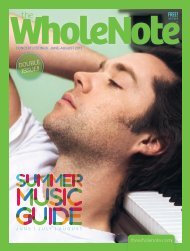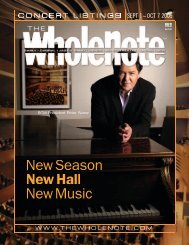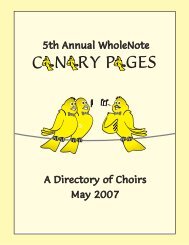You also want an ePaper? Increase the reach of your titles
YUMPU automatically turns print PDFs into web optimized ePapers that Google loves.
Canada’s Jasper Wood has long<br />
been one of my favourite violinists,<br />
ever since he used to come into<br />
the music store where I was working<br />
some ten years ago to promote<br />
his terrific CDs of the Eckhardt-Gramatté<br />
and Gary Kulesha solo Caprices and Saint-<br />
Saëns’ Music for Violin and Piano.<br />
Since then he has built a wideranging<br />
discography, including<br />
CDs of music by Ives, Stravinsky,<br />
Bartók and Morawetz. His latest<br />
CD on the American Max Frank<br />
Music label (MFM 003) is titled<br />
Chartreuse, and features Wood<br />
and his long-time accompanist<br />
David Riley in beautifully judged performances<br />
of sonatas by Mozart,<br />
Debussy and Richard Strauss.<br />
The Mozart is the Sonata<br />
in B-Flat Major K454, and the<br />
playing here — as it is throughout<br />
the CD — is Wood at his usual<br />
best: clean; accurate; tasteful;<br />
sweet-toned; stylish; intelligent and<br />
thoughtful. The Debussy sonata<br />
is given an impassioned reading;<br />
and in the Strauss Sonata in E-Flat<br />
Major, Op.18 Wood and Riley handle<br />
the virtuosic demands with<br />
sensitive subtlety, invoking Brahms<br />
rather than providing a mere display<br />
of fireworks. The sound<br />
throughout is resonant and warm,<br />
and the instrumental balance just right. The<br />
CD digipak comes without booklet notes, but<br />
none are really necessary; listening to this CD<br />
is like being at a memorable live recital.<br />
Cellist Simon Fryer teams up with pianist<br />
Leslie De’Ath on a fascinating CD of Victorian<br />
Cello Sonatas on the independent American<br />
label Centaur Records (CRC 3216). The composers<br />
Algernon Ashton and Samuel Liddle<br />
are probably new to you — they certainly were<br />
to me — but they are representative of that<br />
generation of late 19th century English composers<br />
whose style went out of fashion in the<br />
years before the Great War, and whose works<br />
virtually disappeared from the repertoire.<br />
Not surprisingly, their works here — Ashton’s<br />
Sonata No.2 in G Major from 1882 and<br />
Liddle’s Sonata in E-Flat Major and his Elegy<br />
from 1889 and 1900 respectively — are world<br />
premiere recordings; the Sonata No.2 in D<br />
Minor, Op.39 by Sir Charles Villiers Stanford<br />
completes the recital.<br />
The previously unknown Liddle sonata<br />
was discovered by De’Ath in the course of<br />
his hobby of collecting musical documents<br />
and ephemera. The predominant influence<br />
seems to be German, especially the music of<br />
Mendelssohn and Brahms, but that’s hardly<br />
surprising, given the musical connections<br />
between the two countries in Victorian times.<br />
TERRY ROBBINS<br />
Ashton’s music, although scarcely acknowledged<br />
at home, was widely published in<br />
Germany, where he had studied at the Leipzig<br />
Conservatory; Liddle and Stanford also studied<br />
in Leipzig during the late 1870s, as had<br />
Arthur Sullivan some 20 years earlier.<br />
While the Stanford sonata may be the<br />
stronger work, there is a great deal<br />
of worthwhile and highly attractive<br />
music here, clearly the work of<br />
competent and imaginative craftsmen.<br />
Fryer and De’Ath certainly<br />
present a persuasive case for the<br />
pieces, surmounting the often<br />
formidable technical challenges<br />
with expansive playing that never<br />
resorts to overly Romantic indulgence.<br />
Fryer’s tone in the lower<br />
register is particularly lovely.<br />
Sometimes, admittedly, works<br />
do remain buried or neglected for<br />
good reasons, but CDs like this<br />
one remind us just how rewarding<br />
it can be to take the path<br />
less trodden.<br />
Fans of violinist Christian<br />
Tetzlaff will be delighted with his<br />
new CD of three Mozart Sonatas<br />
for Piano and Violin, with Lars<br />
Vogt at the keyboard (Ondine<br />
ODE 1204-2). The sonatas are<br />
those in B Flat Major K454, G<br />
Major K379 and A Major K526<br />
and Tetzlaff more than lives up to<br />
his usual world-class standard in works that<br />
require not only virtuosity but also a great<br />
deal of sensitivity. His playing seems effortless,<br />
with a smooth legato and a lovely range<br />
of dynamics.<br />
The booklet notes tell us that Vogt and<br />
Tetzlaff are both very conscious of the ambiguity<br />
created in these sonatas by Mozart’s<br />
customary emotional range, and their performances<br />
quite beautifully reflect this.<br />
Tetzlaff apparently came to Mozart’s music<br />
fairly late — well, at 15; late for a prodigy — but<br />
clearly understands that growing older is crucial<br />
to understanding the music.<br />
The sound is spacious without being overly<br />
resonant, with the two instruments clearly<br />
separated but nicely balanced, reminding<br />
us — as does the CD’s title — that these were<br />
not originally written as sonatas for solo violin<br />
with piano accompaniment.<br />
Strings Attached continues at<br />
thewholenote.com with new releases by<br />
the Amar and New Zealand string quartets<br />
(music by Hindemith and Asian composers<br />
respectively), violin music by the Polish<br />
composer Ignaz Waghalter performed<br />
by Irmina Trynkos and American<br />
Serenade featuring Swiss violinist Rachel<br />
Kolly D’Alba.<br />
MODERN & CONTEMPORARY continued from previous page<br />
“World Music” and a pioneer of new sounds<br />
from his own instrument, the piano. His fascinating<br />
1930 Synchrony for orchestra was<br />
originally titled Synchrony of Dance, Music,<br />
Light and was intended as a vehicle for the<br />
American dance pioneer Martha Graham,<br />
who unfortunately lost interest in this multimedia<br />
project. There is undoubtedly a<br />
scenario behind this work which might help<br />
explain its episodic character. Unfortunately<br />
the very meagre program notes leave us in<br />
the dark. Cowell’s rather more conventional<br />
three-movement Piano Concerto was also<br />
composed in that year, with the composer<br />
himself the pianist for the premiere performances.<br />
Both scores make prominent use of<br />
Cowell’s trademark “chord clusters” — aggressive<br />
conglomerations of notes played by<br />
closed fists or open palms — which caused<br />
quite a sensation at the time. Pianist Jeremy<br />
Denk is the soloist in a rousing rendition of<br />
this very propulsive work.<br />
Lou Harrison (1917–2003), a student of<br />
Cowell’s, carried on his mentor’s interest<br />
in Asian musical traditions with a particular<br />
emphasis on Balinese music. His Concerto<br />
for Organ with Percussion Orchestra, completed<br />
in 1973 though incorporating elements<br />
from as far back as 1951, features an excellent<br />
performance from Paul Jacobs. The five movements<br />
of the concerto form a convincing and<br />
satisfying synthesis of Eastern and Western<br />
elements seasoned with a strong French<br />
influence reminiscent of Messiaen. The<br />
percussion section of the orchestra is in particularly<br />
fine form in this invigorating score.<br />
A superlative performance ofthe landmark<br />
1927 <strong>version</strong> of Amériques by Edgard Varèse<br />
(1883–1965) brings the album to a close on a<br />
spectacular note. Tilson Thomas has always<br />
had an uncanny knack for voicing the most<br />
dissonant of chords into a harmonious blend<br />
and here he outdoes himself. These splendid<br />
live performances from 2010 and 2012 are<br />
indispensable fodder for devotees of any of<br />
these unbranded composers.<br />
—Daniel Foley<br />
Barbara Pentland – Toccata<br />
Barbara Pritchard<br />
centrediscs cmccD 18312<br />
! I am very happy<br />
that Centrediscs, a<br />
label on which I also<br />
record, has released<br />
this CD of the solo<br />
piano music of<br />
Barbara Pentland. She<br />
was one of Canada’s<br />
leading composers<br />
who also had a place in the international<br />
avant-garde. Although she favoured serial<br />
techniques she did not let the rules restrict<br />
her. Her music sings and flows with imagination<br />
and colour. These are not the dry ascetic<br />
pieces you might expect from a serialist.<br />
The first piece on the CD, Toccata (1958),<br />
is modelled on the toccatas of Frescobaldi<br />
56 thewholenote.com February 1 – March 7, 2013

















